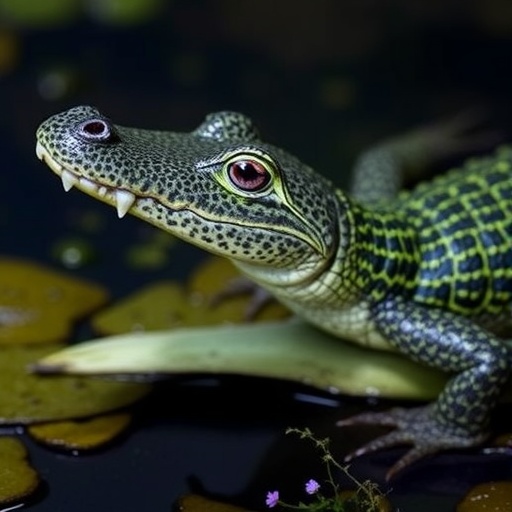Recent pioneering research has shed light on the intricate interplay between the intestinal microbiota and the health of juvenile Chinese alligators. This groundbreaking study, conducted by a team of researchers, delves deep into how size—specifically the physical growth of these reptiles—affects their gut microbiome. With the alarming rates of species decline globally, particularly among reptiles like the Chinese alligator, understanding this relationship holds crucial implications for conservation strategies and species protection.
Understanding how intestinal microbiota impacts health is an emerging focus in modern biological research. The microbiome, a complex ecosystem of bacteria and other microorganisms residing in the gastrointestinal tract, plays a significant role in digestion and overall well-being. However, when it comes to reptiles, studies in this nascent field are sparse. The researchers sought to fill this gap by examining juvenile Chinese alligators, which are particularly susceptible to environmental stresses and are pivotal to the ecological health of their habitats.
The study’s findings reveal a compelling correlation between the size of the alligators and the composition of their gut microbiota. Smaller juvenile alligators exhibited diverse microbiomes that varied in species richness and evenness. This suggests that the health of these young reptiles might be more dependent on their microbiota composition than previously understood. In other words, their growth and survival could be linked to the nuanced levels of microbial diversity in their intestines, impacting everything from nutrient absorption to immune response.
Moreover, the researchers asked a critical question: how does size influence the interaction between the host and its microbial community? The results indicated that as the alligators grew, certain microbial communities became more dominant, potentially influencing their physiology and health outcomes. For instance, larger alligators showed a significant decrease in microbial diversity, which raises questions about what this might mean for their resilience in the face of environmental changes and disease.
The implications of these findings extend beyond academic curiosity; they are vital for conservation efforts aimed at preserving the Chinese alligator population. With habitat loss and human encroachment posing significant threats to these creatures, understanding the links between gut microbiota, health, and size could inform breeding programs that aim to bolster populations. By ensuring that juvenile alligators possess a healthy and diverse microbial community, conservationists can enhance the chances of these species not only surviving but thriving in their natural habitats.
Furthermore, the study tapped into broader ecological concepts such as trophic cascades. The health of alligators, as apex predators, affects the entire ecosystem they inhabit. As these reptiles grow and their microbiomes change, their role within the food web also shifts. A decline in their health could lead to disruptions in the populations of other species, affecting biodiversity and ecosystem stability.
In their quest to optimize species protection strategies, researchers are now exploring how targeted dietary interventions might promote a healthier microbiome among juvenile alligators. This holistic approach to conservation highlights the importance of considering physiological factors, rather than solely focusing on habitat preservation. It is a call to action for conservation biologists to integrate microbiome research into broader wildlife management plans.
One of the more fascinating aspects of this research is its potential to inspire further studies in other reptiles and even other animal classes. The influence of gut microbiota in juvenile organisms is not just a localized phenomenon. This study could pave the way for a revolution in understanding how microbiomes affect growth, health, and survival across various species.
Furthermore, the implications of these findings stretch into public policy concerning wildlife conservation. By presenting evidence that intestinal microbiota can significantly affect growth and health, researchers may influence regulations surrounding habitat conservation practices and species breeding programs. Legislators and policymakers could work more collaboratively with biologists to fund initiatives that explore the microbial implications of wildlife care and management.
The research also underscores the necessity of interdisciplinary collaboration. Conservation efforts typically involve ecologists, geneticists, and other specialists. However, the involvement of microbiologists can provide a richer understanding of the species they aim to protect. This multifaceted approach could lead to innovations in how wildlife is conserved and managed, ultimately enhancing biodiversity preservation efforts.
As the world grapples with an ongoing biodiversity crisis, findings like these serve as a poignant reminder of the complexity of life on Earth. The challenge of conserving species is not merely about protecting habitats; it also requires a nuanced understanding of the organisms that inhabit those spaces. Only by blending traditional conservation methods with advanced scientific exploration can meaningful strides be made in protecting our planet’s precious biodiversity.
This research on juvenile Chinese alligators and their gut microbiota is a testament to how small organisms can have vast implications for large ecosystems. It serves as a call to action for both researchers and policymakers to invest time, resources, and effort into understanding the microbial life that coexists with endangered species. After all, in the intricate web of life, each microbe plays a role in the health of our planet.
In conclusion, this study is not merely an academic pursuit; it has the potential to impact real-world conservation efforts significantly. By understanding the role of the gut microbiome in the health of juvenile Chinese alligators, researchers are paving the way for more informed and effective conservation strategies. As the observations made in this study become integrated into wildlife preservation practices, one can hope that more species, including the Chinese alligator, find a pathway to recovery and sustainability in an ever-changing world.
Subject of Research: Intestinal microbiota and size-dependent effects in juvenile Chinese alligators.
Article Title: Size-dependent effects of the intestinal microbiota in juvenile Chinese alligators: implications for species protection.
Article References:
Li, W., Liu, J., Cui, L. et al. Size-dependent effects of the intestinal microbiota in juvenile Chinese alligators: implications for species protection.
Front Zool 22, 15 (2025). https://doi.org/10.1186/s12983-025-00572-4
Image Credits: AI Generated
DOI: 10.1186/s12983-025-00572-4
Keywords: Gut microbiota, Chinese alligators, conservation, biodiversity, health, ecological impact, juvenile reptiles.




